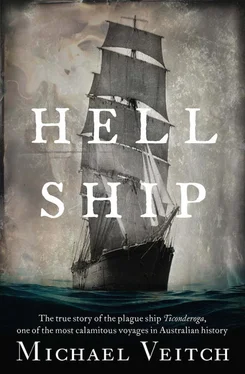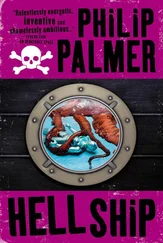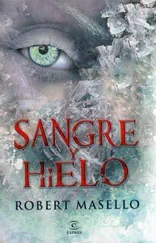As more passengers recovered and more were released from the Lysander , the employed hospital attendants were also let go. This was not so for the Fanning family, who chose to stay on the Lysander , which for the time being would be a permanent part of the station, continuing to serve as a floating hospital. Having set the most sterling example in being among the first of the few at sea to answer the captain’s and the doctors’ calls for volunteer nurses, they continued to do so at the station, Mary as a nurse and John as a cook.
For the majority of those still on the beach, however, the time was approaching to leave it behind. Early on the morning of 22 December, Dr Hunt gave the final signal to depart and, once again, the Ticonderoga ’s passengers began the difficult process of embarkation. Unlike at Birkenhead, however, there was no dock on which to line up, and certainly no brass band playing them off on their way. It was nevertheless another tediously slow process, with the ship’s rowboats being the only means of ferrying people and their luggage to the ship.
None had been in greater need of the weeks of enforced rest than Captain Boyle, who had not only exhausted himself in the course of the terrible voyage, but had lost his own brother on the day they landed. Some of the passengers had not even realised that Boyle was still among them on the beach camp, but now he was quite literally back at the helm, directing the little flotilla of boats and again issuing commands to the crew in preparation to sail.
It took many hours for the hundreds of passengers, as well as their luggage, to be reloaded onto the ship. Many had dreaded the idea of ever setting foot on her again, and would have preferred the trials of any kind of overland route to Melbourne if one could have been arranged. For the many passengers who had lost family members while at sea, it was a particularly unwelcome reunion with the vessel, associating it as they did with nothing but death, filth and suffering. A handful of patients, still gravely ill, remained on the Lysander with their supporting families—some to recover, others to be numbered among the Ticonderoga ’s final dead. For those who had the capacity to comprehend it, however, the imminent departure of the Ticonderoga while they remained in hospital must have seemed a death sentence in itself.
As soon as people stepped foot on board the Ticonderoga , they immediately felt they could have been on a different vessel entirely. The ship they had remembered from the voyage was now almost unrecognisable.
The first thing they noticed was the smell—or rather, the lack of it. The revolting typhus stench of hundreds of dead and dying people, which had seemed to pervade the very beings of those subjected to its stink, was now gone, replaced by the strong, acrid waft of the limewater that the crew had applied to every surface. The deck was tidy, ropes were properly coiled and a sense of order prevailed. That section where, several weeks earlier, corpses awaiting burial had been piled horribly under a rough piece of canvas was now just another part of the foredeck.
Down below, the difference was even more stark. Several fresh coats of whitewash had transformed the filth and gloom of the voyage’s terrible denouement into a clean and orderly internal area that, on account of all the bunks having been disposed of, was also now remarkably more spacious. This, ironically, left precious few places to sit, and passengers now had to squeeze themselves and their trunks into any nook they could secure for the several hours’ journey up to Hobson’s Bay.
Before their departure, all those on deck, having once again picked out some of their better clothes for their belated arrival into Melbourne, stood transfixed as the last of the rowboats returned to the ship, laden not with people, but with some of the large pile of luggage that had, for all the weeks of quarantine, been kept out of the weather at a quiet corner of the beach. This colourful collection of trunks and boxes was the luggage of the dead, being brought solemnly back to the ship, the names of their deceased owners still clearly marked on the sides. The passengers watched the melancholy progress of the little boats quietly, as if observing a funeral procession. Then their eyes turned back to the shore, to the cemetery that had started as a patch of green but that now held nearly 70 of those who would never complete their journey. Even from the deck, some of the graves could be made out, marked by raw blocks of sandstone pulled up from the beach or some bits of timber purloined from the ship. Other graves were more pathetic, and perhaps even more poignant, indicated by nothing more than a couple of sticks nailed into a little cross. Many other passengers were simply buried in unmarked graves, decorated with little scatterings of seashells, pebbles and some of the more colourful wildflowers that abound on the peninsula in spring.
Weighing anchor at last, the Ticonderoga caught some of the warm wind blowing from the west and, again under the command of Thomas Boyle, turned away from the little beach forever.
The sight that greeted the people on board the Ticonderoga as she approached Melbourne’s port in Hobson’s Bay was an astonishing one. Even in ports much larger than this, Captain Boyle noted, it would be rare to find such a forest of masts. Dozens and dozens of ships of all sizes lay before them in the bay, and all with their sails reefed and their decks utterly empty—abandoned in a ghost town of sail. This was a picture of a city drained by a gold rush. For some time now, ships’ masters had been reluctant to even tie up at the Hobson’s Bay wharf, as their crews would immediately descend the rails and bolt off, seeking the quickest way to the goldfields. Standing off in deeper water, however, had done little to slow the practice, as smaller boats—keen to charge seamen a premium for quickly spiriting them away under the noses of their captains—had probably made more money than they could ever have hoped to at the Ballarat diggings.
A large ship like the Ticonderoga could likewise be guaranteed to be surrounded by a small flotilla eager to begin disembarking her passengers. Captain Boyle brought his big ship within sight of the large jetty at Hobson’s Bay. There he dropped anchor and waited. Not a boat came near them. Some of the passengers, bewildered, waved handkerchiefs and called, but to no avail. Some of the craft in fact had set off in the opposite direction as soon as the Ticonderoga came to rest. Captain Boyle cursed bitterly to himself. He had suspected exactly this scenario might well occur, despite the many assurances ha had been given that any number of boats would be eager to disembark his passengers.
The Ticonderoga ’s reputation had preceded her arrival into Melbourne. Ever since that first sensational headline appeared in early November, readers of The Argus had been lapping up every morbid detail of this ‘plague ship’. Now nobody wanted to go near her. Even the hardened men of the small taxiing boats were wary of this big black beauty, allegedly riddled with disease. The papers had reported both yellow fever and scarlatina, but the rumour mill amplified this to include every ailment known to man. Hundreds had perished horribly within her wooden walls. Worse, she was not even British, but an American vessel—a Hell Ship—having journeyed through God knows what pestilential waters, picking up the dreaded yellow jack of the American south. One boat, at last, stood off from the Ticonderoga a nd answered the appeals of her passengers and crew. It was to no avail. The sailor apologised, but said they would simply have to wait there on board—wait for what exactly he did not say before once again disappearing.
Читать дальше












